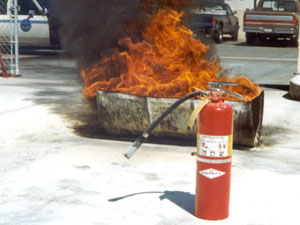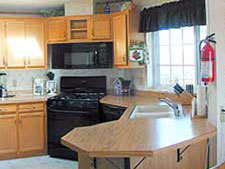 All fires can be very dangerous and life-threatening. Your safety should always be your primary concern when attempting to extinguish a fire.
All fires can be very dangerous and life-threatening. Your safety should always be your primary concern when attempting to extinguish a fire.
Before Deciding To Extinguish A Fire, Be Certain That . . .
- The fire is small and not spreading. A fire can double in size within two or three minutes.
- You have the proper fire extinguisher for what is burning.
- The fire won't block your exit if you can't control it. A good way to ensure this is to keep the exit at your back.
- You know your fire extinguisher works. Inspect extinguishers once a month for dents, leaks or other signs of damage. Assure the pressure is at the recommended level. On extinguishers equipped with a gauge, the needle should be in the green zone-not too high and not too low.
- You know how to use your fire extinguisher. There's not enough time to read instructions when a fire occurs.
How To Extinguish A Small Fire Safely
- Always stand with an exit at your back.
- Stand several feet away from the fire, moving closer once the fire starts to diminish.
- Use a sweeping motion and aim at the base of the fire.
- If possible, use a "buddy system" to have someone back you up or call for help if something goes wrong.
- Be sure to watch the area for a while to ensure it doesn't re-ignite.
How To Use A Fire Extinguisher
Before using your fire extinguisher, be sure to read the instructions before it's too late. Although there are many different types of fire extinguishers, all of them operate in a similar manner.
Use this acronym as a quick reference: P-A-S-S
- Pull the Pin at the top of the extinguisher. The pin releases a locking mechanism and will allow you to discharge the extinguisher.
- Aim at the base of the fire, not the flames. This is important-in order to put out the fire, you must extinguish the fuel.
- Squeeze the lever slowly. This will release the extinguishing agent in the extinguisher. If the handle is released, the discharge will stop.
- Sweep from side to side. Using a sweeping motion, move the fire extinguisher back and forth until the fire is completely out. Operate the extinguisher from a safe distance, several feet away, and then move towards the fire once it starts to diminish. Be sure to read the instructions on your fire extinguisher-different fire extinguishers recommend operating them from different distances. Remember: Aim at the base of the fire, not at the flames!!!!
A typical fire extinguisher contains 10-15 seconds of extinguishing power if fully charged. Always read the instructions that come with the fire extinguisher beforehand and become familiarized with its parts.
Once the fire is out, don't walk away! Watch the area for a few minutes in case it re-ignites. Recharge or replace the extinguisher immediately after use.
Any sort of fire will produce some amount of carbon monoxide, the most deadly gas produced by a fire. Materials such as wool, silk, nylon and some plastics can produce other highly toxic gases such as carbon dioxide, hydrogen cyanide, or hydrogen chloride. Beware-all of these can be fatal.
Where To Place Fire Extinguishers In Your Home
 It is recommended to have at least one fire extinguisher on each level of your home. Keep them in plain sight and no more than five feet above the floor. Do not put them in closets because that will cost you valuable time when you are reaching for it. And even though a fire extinguisher may not match your décor, do not hide it behind curtains or drapes.
It is recommended to have at least one fire extinguisher on each level of your home. Keep them in plain sight and no more than five feet above the floor. Do not put them in closets because that will cost you valuable time when you are reaching for it. And even though a fire extinguisher may not match your décor, do not hide it behind curtains or drapes.
The most important places to have a fire extinguisher are in areas that are more susceptible to fire. These areas are the kitchen and the garage.
Kitchen: According to U.S. Fire Administration statistics, the kitchen is the place where fires most often start. You should not have to risk burns just to reach your extinguisher. Therefore, the best place to put the fire extinguisher is by the kitchen door so you have easy access to it. Note, however, that an improperly used fire extinguisher can spread a grease fire in a frying pan. Instead, simply slide a lid on the pan, turn off the heat, and allow it to cool. If no lid is available, use a larger pan, a cookie sheet, or pizza pan.
Garage: It is a good idea to keep a fire extinguisher here because in most homes, this is the place we use as storage. Often, leftover paints, solvents, and building materials will be piled up without a second thought. Again, the best location to mount the fire extinguisher is by the door.
How To Maintain Your Fire Extinguishers
- Inspect fire extinguishers at least once a month : The extinguisher is not blocked by equipment, coats or other objects that could interfere with access in an emergency.
- The pressure is at the recommended level. On extinguishers equipped with a gauge (such as that shown on the right), the needle should be in the green zone-not too high and not too low.
- The nozzle or other parts are not hindered in any way.
- The pin and tamper seal (if it has one) are intact.
- There are no dents, leaks, rust, chemical deposits and/or other signs of abuse/wear. Wipe off any corrosive chemicals, oil, gunk etc. that may have deposited on the extinguisher.
Some manufacturers recommend shaking your dry chemical extinguishers once a month to prevent the powder from settling/packing.
Fire extinguishers should be pressure tested (a process called hydrostatic testing) after a number of years to ensure that the cylinder is safe to use. Consult your owner's manual, extinguisher label or the manufacturer to see when yours may need such testing.
If the extinguisher is damaged or needs recharging, replace it immediately!
IMPORTANT: Recharge all extinguishers immediately after use regardless of how much they were used.
Information provided by NFPA.org.